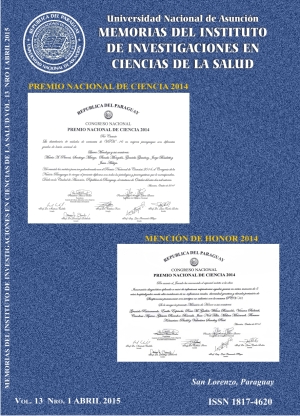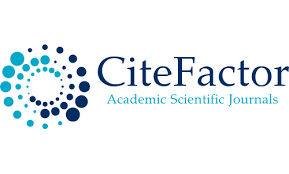Frecuencia de genes que codifican factores de virulencia en Staphylococcus aureus aislados de niños que concurrieron al Hospital General Pediátrico Niños de Acosta Ñú, durante el año 2010
Palabras clave:
Staphylococcus aureus, factores de virulencia, PCR.Resumen
Staphylococcus aureus es un microorganismo con habilidad de infectar diferentes tejidos celulares, por portar genes que le confieren resistencia a antibióticos, factores de virulencia y su plasticidad genética, que podrían contribuir a una progresión rápida y complicada de la enfermedad. El Paraguay no cuenta con datos epidemiológicos que indiquen los factores de virulencia que presentan las cepas de S. aureus, por lo que el objetivo del trabajo fue determinar un perfil de virulencia detectando los genes codificantes de: hemolisinas α y β, enterotoxinas A, B, C, D, H y toxinas exfoliativas A y B. Este estudio observacional descriptivo de corte transverso, con muestreo no probabilístico de casos consecutivos, incluyó 50 aislados de S. aureus obtenidos a partir de muestras clínicas de secreciones de piel, partes blandas o líquidos corporales de pacientes menores de 17 años que concurrieron al Hospital General Pediátrico Niños de Acosta Ñú durante el año 2.010. Las reacciones de PCR incluyeron la detección de los genes: sea+seb+sec+ADNr16S, hlA+hlB, eta+etb, sed y seh. El 82% de los aislados provenía de niños que presentaron cuadros clínicos compatibles con infecciones de piel y partes blandas y el 18% de cuadros clínicos graves como sepsis, osteomielitis y neumonías. Los aislados contaban con datos de portación de Leucocidina de Panton-Valentine, el cual fue el factor de virulencia más frecuentemente detectado (58%), seguido de las hemolisinas alfa (16%) y beta (8%). Las enterotoxinas y las toxinas exfoliativas fueron menos frecuentes (0-2%), y no se detectaron genes codificantes de las enterotoxinas C y D.
Descargas
Citas
Malachowa N, Sabat A, Gniadkowski M, Krzyszton-Russjan J, Empel J, Miedzobrodzki J, et al. Comparison of multiple-locus variable-number tandem-repeat analysis with pulsed-field gel electrophoresis, spa typing, and multilocus sequence typing for clonal characterization of Staphylococcus aureus isolates. J Clin Microbiol. 2005; 43(7):3095–100.
Collery MM, Smyth DS, Twohig JM, Shore AC, Coleman DC, Smyth CJ. Molecular typing of nasal carriage isolates of Staphylococcus aureus from an Irish university student population based on toxin gene PCR, Agr locus types and multiple locus, variable number tandem repeat analysis. J Med Microbiol. 2008; 57(3):348–58.
Paganini M, Della LP, Muller OB, Ezcurra G, Uranga M, Aguirre C, et al. Infecciones por Staphylococcus aureus resistente a meticilina adquiridas en la comunidad en niños antes sanos y en niños relacionados al hospital en la Argentina. Rev chil infectol. 2009; 26(5):406–12.
Sauer P, Síla J, Štosová T, Večeřová R, Hejnar P, Vágnerová I, et al. Prevalence of genes encoding extracellular virulence factors among meticillin-resistant Staphylococcus aureus isolates from the University Hospital, Olomouc, Czech Republic. J Med Microbiol. 2008; 57(4):403–10.
Ritz N, Curtis N. The role of panton-valentine leukocidin in Staphylococcus aureus musculoskeletal infections in children. Pediatr Infect Dis J. 2012; 31(5):514–8.
Shallcross LJ, Williams K, Hopkins S, Aldridge RW, Johnson AM, Hayward AC. Panton–valentine leukocidin associated staphylococcal disease: A cross-sectional study at a London hospital, England. Clin Microbiol Infect. 2010; 16(11):1644–8.
Bae I-G, Tonthat GT, Stryjewski ME, Rude TH, Reilly LF, Barriere SL, et al. Presence of genes encoding the panton-valentine leukocidin exotoxin is not the primary determinant of outcome in patients with complicated skin and skin structure infections due to Methicillin-resistant Staphylococcus aureus: Results of a multinational trial. J Clin Microbiol. 2009; 47(12):3952–7.
Wang X, Meng J, Zhang J, Zhou T, Zhang Y, Yang B, et al. Characterization of Staphylococcus aureus isolated from powdered infant formula milk and infant rice cereal in China. Int J Food Microbiol. 2012; 153(1-2):142–7.
Lina G, Piémont Y, Godail-Gamot F, Bes M, Peter M-O, Gauduchon V, et al. Involvement of panton-valentine Leukocidin—producing Staphylococcus aureus in primary skin infections and pneumonia. Clin Infect Dis. 1999; 29(5):1128–32.
Day SR, Moore CM, Kundzins JR, Sifri CD. Community-associated and healthcare-associated methicillin-resistant Staphylococcus aureus virulence toward Caenorhabditis elegans compared. Virulence. 2012 ;3(7): 576-82
Plano LRW, Gutman DM, Woischnik M, Collins CM. Recombinant Staphylococcus aureus Exfoliative toxins are not bacterial superantigens. Infect Immun. 2000; 68(5):3048–52.
Kato F, Kadomoto N, Iwamoto Y, Bunai K, Komatsuzawa H, Sugai M. Regulatory mechanism for Exfoliative toxin production in Staphylococcus aureus. Infect Immun. 2011; 79(4):1660–70.
Manfredi EA, Leotta GA, Rivas M. PCR múltiple para la detección de los genes sea, seb, sec, sed y see de Staphylococcus aureus: Caracterización de aislamientos de origen alimentario. Revista argentina de microbiología. 2010;42(3):212–5.
Sola C, Gribaudo G, Vindel A, Patrito L, Bocco JL. Identification of a novel Methicillin-resistant Staphylococcus aureus epidemic clone in Córdoba, Argentina, Involved in nosocomial infections. J Clin Microbiol. 2002; 40(4):1427–35.
Carpinelli L. Caracterización fenótípica y genotípica de Staphylococcus aureus aislados de trabajadores de la salud de un centro hospitalario de referencia nacional /Tesis/. Asunción: UNA. Dirección General de Postgrado, Dirección General de Investigación Científica y Tecnológica, IICS; 2011.
Guillén R, Basualdo W, Campuzano de Rolón A, Macchi M, Ortellado J, Almada P, et al. Staphylococcus aureus adquiridos en la comunidad: Caracterización clínica, fenotípica y genotípica de aislados en niños que concurren a hospitales de referencia de Paraguay. Rev Inst Med Trop. 2011; 6:49.
Murakami K, Minamide W, Wada K, Nakamura E, Teraoka H, Watanabe S. Identification of Methicillin-resistant strains of staphylococci by polymerase chain reaction. J Clin Microbiol. 1991; 29(10):2240–4.
Wertheim H, Melles D, Vos M, Vanleeuwen W, Vanbelkum A, Verbrugh H, et al. The role of nasal carriage in infections. Lancet Infect Dis. 2005; 5(12):751–62.
Lan J, Walboomers JM, Roosendaal R, van Doornum GJ, MacLaren DM, Meijer CJ, et al. Direct detection and genotyping of Chlamydia trachomatis in cervical scrapes by using polymerase chain reaction and restriction fragment length polymorphism analysis. J Clin Microbiol. 1993; 31(5):1060–5.
Strommenger B, Braulke C, Pasemann B, Schmidt C, Witte W. Multiplex PCR for rapid detection of Staphylococcus aureus isolates suspected to represent community-acquired strains. J Clin Microbiol. 2008; 46(2):582–7.
Johnson AP, Pearson A, Duckworth G. Surveillance and epidemiology of MRSA bacteraemia in the UK. J Antimicrob Chemother. 2005; 56(3):455–62.
Weiler N, Leotta GA, Zarate MN, Manfredi E, Alvarez ME, Rivas M. Brote de intoxicación alimentaria asociado al consumo de leche ultrapasteurizada en la República del Paraguay. Revista Argentina de Microbiología. 2011; 43:33–6.
Larsen HD, Aarestrup FM, Jensen NE. Geographical variation in the presence of genes encoding superantigenic exotoxins and beta-hemolysin among Staphylococcus aureus isolated from bovine mastitis in Europe and USA. Vet Microbiol. 2002; 85(1):61–7.
Xie Y, He Y, Gehring A, Hu Y, Li Q, Tu S-I, et al. Genotypes and toxin gene profiles of Staphylococcus aureus clinical isolates from China. PLoS ONE. 2011; 6(12):e28276.
Wu D, Li X, Yang Y, Zheng Y, Wang C, Deng L, et al. Superantigen gene profiles and presence of exfoliative toxin genes in community-acquired meticillin-resistant Staphylococcus aureus isolated from Chinese children. J Med Microbiol. 2011; 60(1):35–45.
Peacock SJ, Moore CE, Justice A, Kantzanou M, Story L, Mackie K, et al. Virulent combinations of adhesin and toxin genes in natural populations of Staphylococcus aureus. Infect Immun. 2002; 70(9):4987–96.














